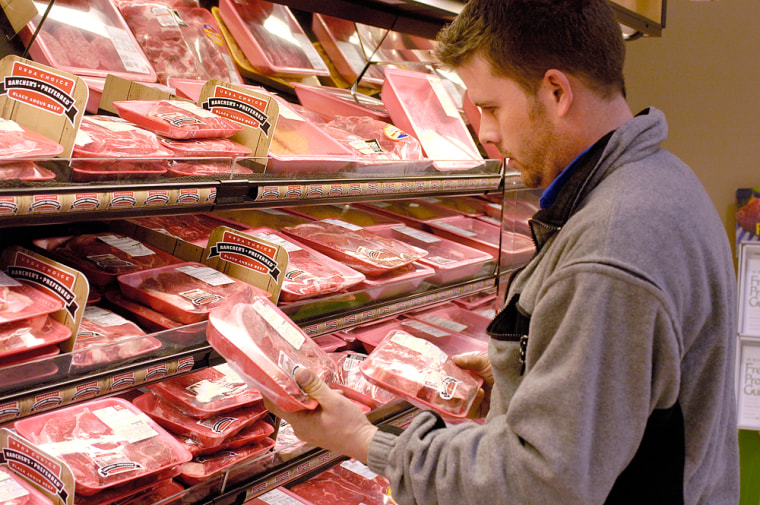Dan Hogan admitted he had only a vague idea of what he was doing as he poked through the beef case, looking for dinner.
Like many in his generation, the 32-year-old Burnsville man didn’t pick up much cooking knowledge growing up.
“We fended for ourselves at home,” he said while looking at the variety of beef cuts available at his Cub Foods supermarket. “The extent of our beef was Hamburger Helper.”
Cargill Inc. — the second-biggest U.S. meat processor behind Tyson Foods Inc. — is betting that there are a lot of people like Hogan out there. The agribusiness giant and one of its units are launching a marketing campaign that targets consumers — especially younger ones — who may be clueless about chuck roasts, round steaks, briskets and tri-tips.
The campaign comes at a time of surplus in the beef and poultry industries that should translate into better prices for consumers and lower costs for meatpackers this summer, according to Cargill officials and Clinton Meyer, an analyst with Burnham Securities Inc. who follows Tyson.
The drought in the Southwest is leading producers there to send their cattle to market early, they said, while concerns about mad cow disease have hurt beef exports. And even before the bird flu scare, Meyer said, the poultry industry was already suffering from large oversupplies and weak export markets.
To maintain and increase their profitability, Meyer said, companies like Cargill and Tyson are stressing premium brands as part of their marketing programs.
Cargill’s campaign features labels that help consumers figure out what to do with a particular piece of meat, online promotions and advice, and cuts that make sense for single people or smaller households.
The campaign is based on the company’s own research, which found that eight of 10 shoppers were baffled by the meat case at their stores.
There’s always been high demand for tender cuts from the middle of the cow — the rib, the loin and sirloin. But most of the meat is in the tougher chuck and round — the shoulder and rump.
“We’ve got to sell all of it,” said Herb Meischen, vice president of strategy and consumer development for Cargill Meat Solutions in Wichita, Kan.
Falloff in culinary knowledge
Cargill’s survey found that shoppers’ knowledge of beef depended a lot on their age. Those older than 45 tended to have grown up with stay-at-home mothers. Those younger tended to have had working moms, like Hogan, and thus a big falloff in passing down culinary knowledge.
The survey wasn’t scientific, but the findings fit the experience of Andrew Zimmern, a Minnesota-based chef, TV and radio personality, food writer and cooking teacher.
“The meat counter at the supermarket confuses 99 percent of the people, in my estimation,” Zimmern said. In fact, he said, he gets more questions about meat cuts than just about anything else.
For Meischen, the dilemma is how to educate consumers.
“What if you’re 25 years old and you haven’t had any skills, teaching or any desire to learn? What would stir you to experiment with an eight- to 10-dollar piece of meat?” he asked.
What Cargill is doing, as it promotes its Sterling Silver and AngusPride premium brands, is trying to unravel the mystery.
One strategy is consumer-friendly labeling, said Kent Harrison, group brand manager for premium beef programs at Cargill Meat Solutions in Wichita. Packages show if a cut is right for the grill or best as a pot roast, or if a grade of ground beef is best for hamburger patties or Hamburger Helper. The labels often have recipes.
The company is also promoting its brands online. One new site — www.beefquiz.com — offers a Beef IQ quiz and rewards those who do well with coupons worth up to $4 off Sterling Silver beef. AngusPride has a similar site — www.angusquiz.com. Both link to recipes and other information, and visitors can sign up for e-mail lists.
Convenience is a key to those younger consumers, too. Instead of just offering a huge steak that might feed two, Harrison said, the same meat might come in small medallions that serve one.
Premium brands make up about 10 to 15 percent of Cargill’s beef business, Meischen said, but they’re more profitable than ordinary beef. Privately held Cargill doesn’t release performance figures for its individual business units, but says its overall meat sales are growing, both in dollars and pounds.
Retailers have long recognized the need to make things as easy as possible for consumers.
Meat departments at Cub Foods, a mass market chain of the food giant Supervalu Inc., emphasize ready-to-cook items, said Jeff Sahr, director of meat and seafood. And it’s among the many retailers who provide recipes in its ads and in stores.
Others, such as Minnesota’s upscale Lunds and Byerly’s stores, showcase full-service meat counters with butchers who still do much of the cutting in-house and have the expertise to guide learning shoppers. They offer large selections of recipe cards.
Hogan, the Cub shopper, will take any help he can get. After much poking in the meat case searching for something that would work for steak and eggs, he finally settled hopefully on a package labeled “beef tip steak cap off thin.”
He said he fits Cargill’s profile of a shopper baffled by beef.
“Not a clue,” he admitted. “Exactly.”
